Working with color is one of my favorite aspects of soap making. I collect tons of color inspiration via Pinterest, magazines, Instagram, nature and fashion. When selecting colorants to use in soap, there are plenty of options including LabColors, clay, micas and color blocks for melt and pour. My go-to colorants are often pigments; they are non-bleeding, produce vibrant color and do not morph in cold process soap.
Part of the fun of working with colors is mixing to create unique shades. Blending colorants can seem a little intimidating at first. But with only three colors, you can create an entire color wheel. To demonstrate how to experiment with color blending I chose three colors to represent the primary colors of the color wheel: Ultramarine Blue Pigment, Fizzy Lemonade Colorant and Electric Bubble Gum Colorant.
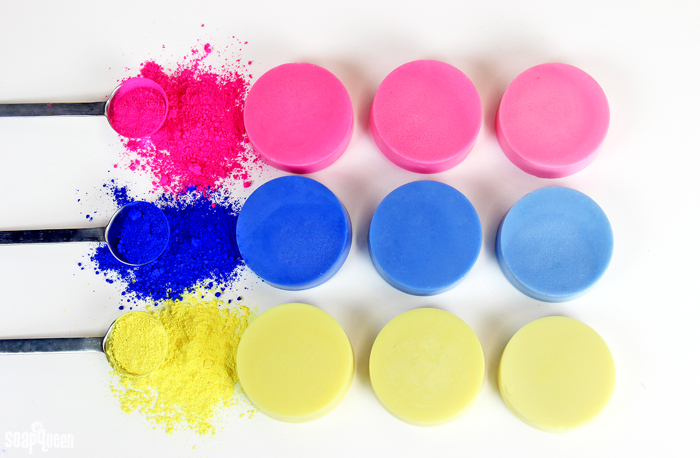
Why pink instead of red? A vibrant red can be tricky to achieve in cold process soap. My favorite red is made using one part Merlot Sparkle Mica to two parts Electric Bubble Gum. In order to keep the blends simple, Electric Bubble Gum represents the color red in these mixtures. The bright pink hue keeps the colors looking vibrant while adding a similar effect of a “true red.”
Below are the three “primary” colors used at different usage rates. The soaps shown represent using the colorants at 1/4 tsp. per pound of cold process soap, 1/2 tsp. per pound and 1 tsp. per pound. “Per pound” refers to the total yield of the soap, rather than the oils used in the recipe. All colorants have been dispersed in a lightweight carrier oil at a rate of 1 teaspoon of colorant to 1 tablespoon oil. For more information on how to disperse colorants for cold process soap, check out this Soap Queen TV video. It’s interesting to see that for some colorants, such as the Ultramarine Blue, the amount used places a huge role in the color. While for the Fizzy Lemonade, it does not affect the color as dramatically.
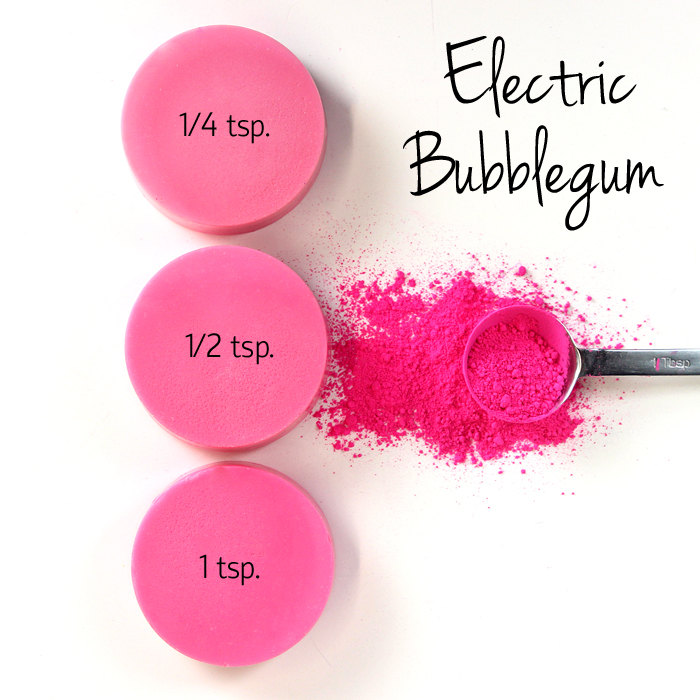 Electric Bubble Gum Colorant, top to bottom: 1/4 tsp. per pound of soap, 1/2 tsp. per pound of soap, 1 tsp. per pound of soap.
Electric Bubble Gum Colorant, top to bottom: 1/4 tsp. per pound of soap, 1/2 tsp. per pound of soap, 1 tsp. per pound of soap.
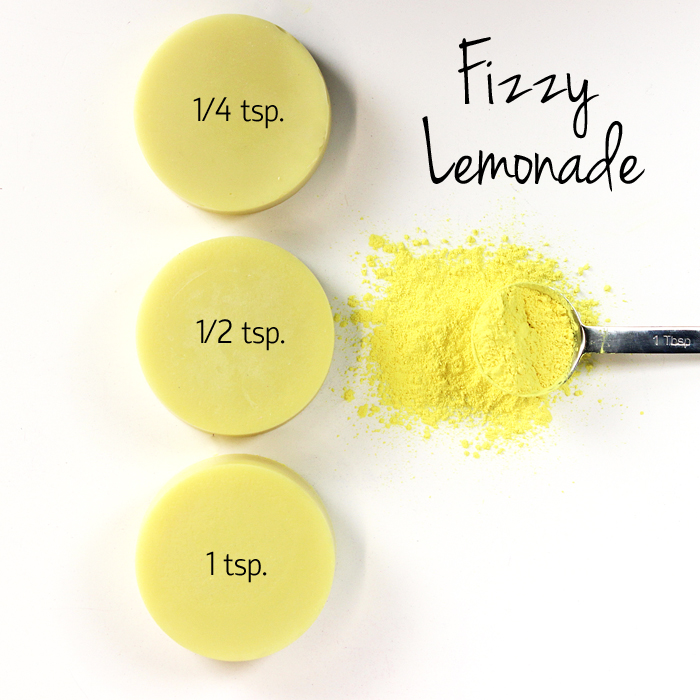 Fizzy Lemonade Colorant, top to bottom: 1/4 tsp. per pound of soap, 1/2 tsp. per pound of soap, 1 tsp. per pound of soap.
Fizzy Lemonade Colorant, top to bottom: 1/4 tsp. per pound of soap, 1/2 tsp. per pound of soap, 1 tsp. per pound of soap.
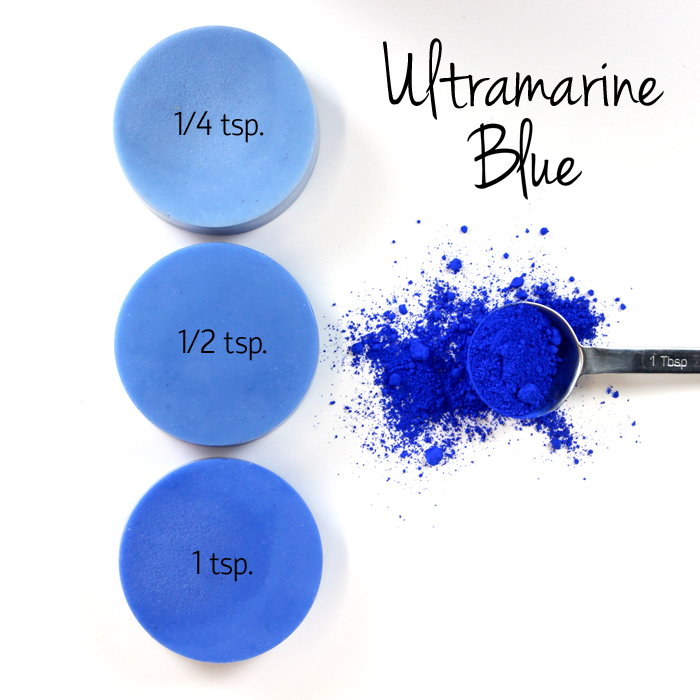
Ultramarine Blue Pigment, top to bottom: 1/4 tsp. per pound of soap, 1/2 tsp. per pound of soap, 1 tsp. per pound of soap.
Time to get mixing! Below are shades that can be achieved with mixing the Ultramarine Blue, Fizzy Lemonade and Electric Bubble Gum. The amounts listed are before being dispersed in a tablespoon of carrier oil. Each disk of soap has been colored with a total of one teaspoon of dispersed colorant, but the percentages of each varies. Mixing these three colors creates beautiful hues of green, purple and orange.
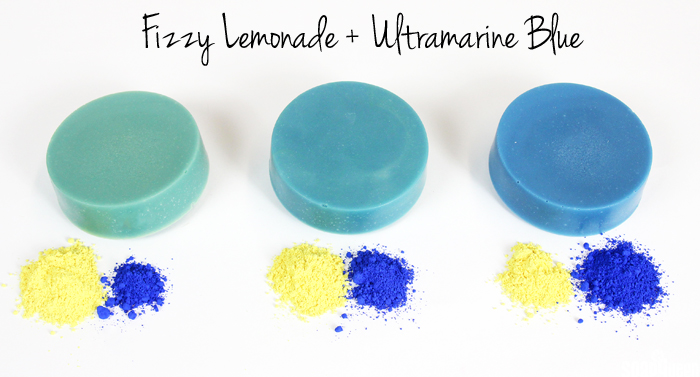 Left to right: .75 tsp. Fizzy Lemonade + .25 tsp. Ultramarine Blue
Left to right: .75 tsp. Fizzy Lemonade + .25 tsp. Ultramarine Blue
.5 tsp. Fizzy Lemonade + .5 tsp. Ultramarine Blue
.25 Fizzy Lemonade + .75 tsp. Ultramarine Blue
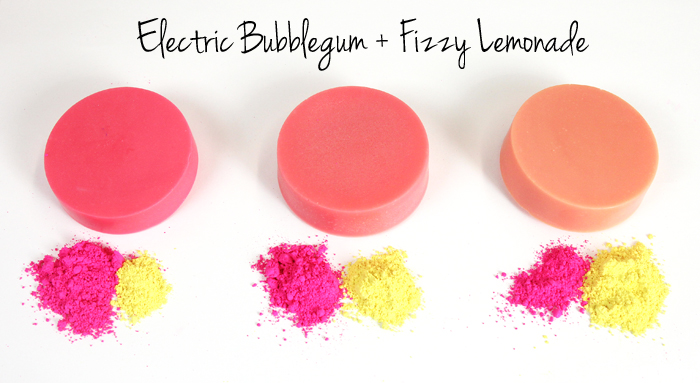 Left to right: .75 tsp. Electric Bubble Gum + .25 tsp. Fizzy Lemonade
Left to right: .75 tsp. Electric Bubble Gum + .25 tsp. Fizzy Lemonade
.5 tsp. Electric Bubble Gum+ .5 tsp. Fizzy Lemonade
.25 tsp. Electric Bubble Gum + .75 tsp. Fizzy Lemonade
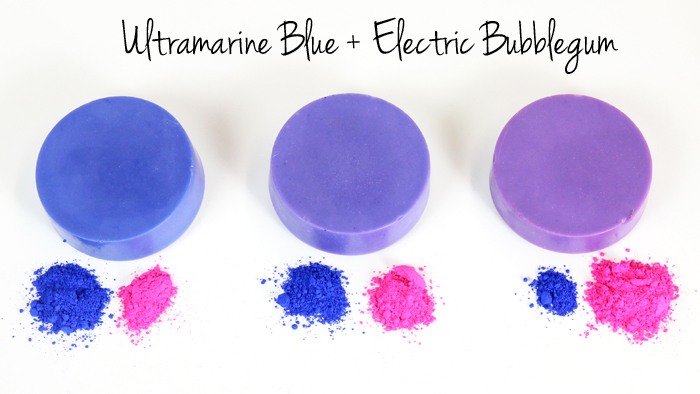 Left to right: .75 tsp. Ultramarine Blue + .25 tsp. Electric Bubble Gum
Left to right: .75 tsp. Ultramarine Blue + .25 tsp. Electric Bubble Gum
.5 tsp. Ultramarine Blue + .5 tsp. Electric Bubble Gum
.25 tsp. Ultramarine Blue + .75 tsp. Electric Bubble Gum
Creating your own shades is incredibly fun. With so many colorants, the possibilities are abundant! Below are some tips and things to consider when mixing colorants to create unique shades:
- Keep the color wheel in mind, and make deliberate decisions when adding colors.
- When mixing colorants, adding two colorants at 50/50 is a great place to start. Then, you can easily adjust either color to get the shade you’re looking for.
- Having white and black colorants on hand can lighten or darken colors.
- Consider mixing two colors in the same family (pinks with pinks, blues with blues, etc.) to create a totally new shade.
- Don’t forget to take notes! Once you find the perfect color, you’ll want to be able to recreate it.
- Decide how you like to blend colors, and be consistent. For example, some soapers like to disperse their colorants and add the various shades directly to the soap. Others like to disperse the colorants, and combine the liquids together and add them to their soap. Either way is fine, but it can be helpful to be consistent.
- If you are doing a lot of blending, it may be helpful to disperse large amounts of colorants in a sealable jar. That way you can blend the liquids and easily start over if the color does not work.
Do you enjoy mixing colorants to create unique shades? If you have any blending tips, I would love to hear them!
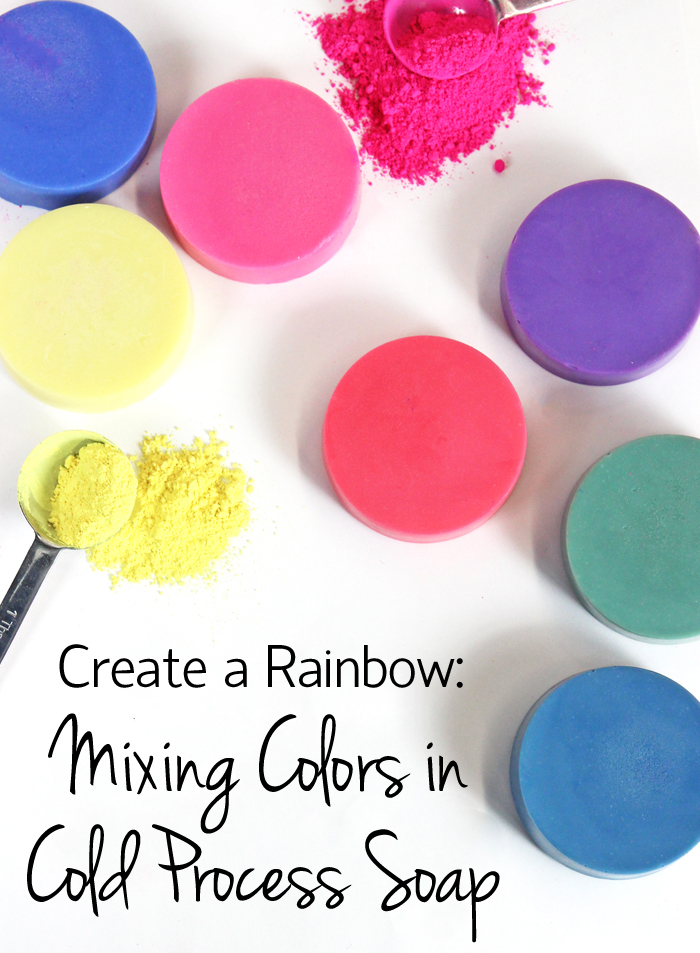
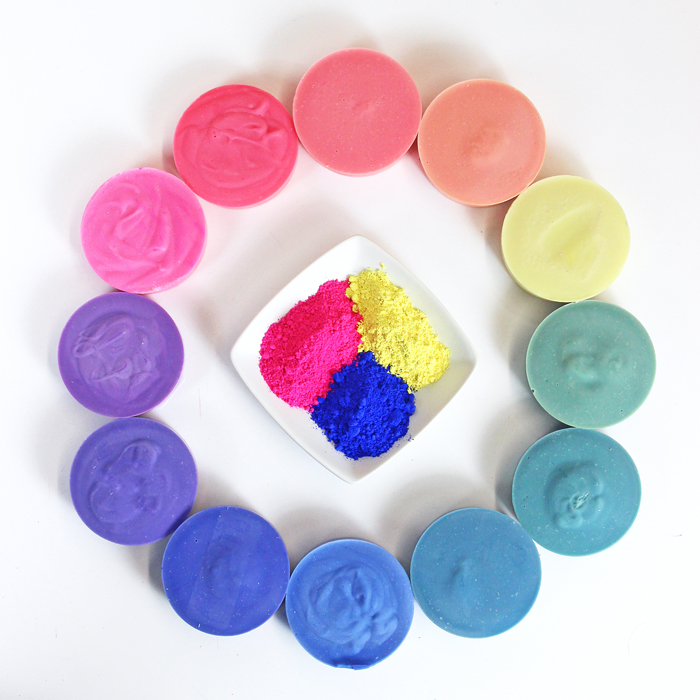
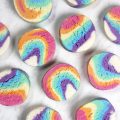
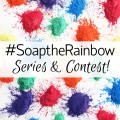
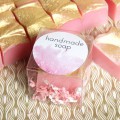
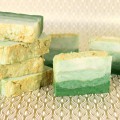
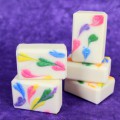
You really amaze me -some day I will buy every color- I love color as you might know by now. be able to mix is imperative.
Oh thank you so much Eileen, that means a lot to us! Color is so much fun to experiment with, I love it too. The great thing is if you don’t have a lot of colors, you can blend them to create unique shades! 🙂
-Kelsey with Bramble Berry
I needed a very light pink for.my CP…. I used Titanium and Cellini Red…. they were perfect mixed and also as I assembled my soap. But when I unwrapped, it had turned Orange! Should I have put in freezer for processing or left uncovered during gel phase?
Hi Joanne!
Certain micas can morph in cold process, including the Cellini Red. It turns the soap an orangey peach color. The color is still beautiful, but probably not what you were going for!
You can still use micas in cold process soap though! Certain colors, like Aqua Pearl Mica, work great in soap. Each color will say how it performs in the descriptions on BrambleBerry.com. If they morph or fade, you can use them as a mica line or mica painting. Find out more in the Sunday Night Spotlight: Mica Colorants post: http://www.soapqueen.com/bath-and-body-tutorials/tips-and-tricks/sunday-night-spotlight-mica-colorants/
Ultramarine Pink Pigment would give you a gorgeous soft pink color. Pigments are great for use in cold process soap. They don’t fade or morph, and add gorgeous color.
Ultramarine Pink: https://www.brambleberry.com/Ultramarine-Pink-Oxide-Pigment-P4039.aspx
Learn more about coloring cold process soap in this Talk It Out Tuesday: Colorants post: http://www.soapqueen.com/bath-and-body-tutorials/tips-and-tricks/talk-it-out-tuesday-colorants/
-Kelsey with Bramble Berry
Have you tested each of these soaps at the rates used to see if they have colored bubbles. I’ve learned the hard way that with oxides and ultramarines, its really easy to cross over that line and end up with colored lather. I always want to know where that line is for EACH different pigment, because it doesn’t seem to be the same for each one. Many thanks for this post. Very informative and helpful.
Hi Jennifer!
All of the colorant amounts listed here lathered clear. None of the amounts create colored lather. Hooray!
Also, you are correct – because each colorant is different, some may color the lather at the same amounts that another color may not. We test all of our recipes to see if that lather is colored. If we do notice any colors, we let you know in the blog post. 🙂
-Kelsey with Bramble Berry
I am just learning to make melt and pour soaps and lotions. What is the difference between coloring your soap with liquid color or using the powders?
Hi Glenny!
The liquid colorants Bramble Berry carries are mixed with glycerin. We love using them in melt and pour because they mix in nice and smooth! However, they don’t work in cold process soap.
Liquid colors: https://www.brambleberry.com/Liquid-Colors-C44.aspx
Micas in powder form can be added to your melt and pour as is. Simply add the colorant and stir well. You can use up to 1/2 ounce per pound of soap.
If you’re using oxides (pigments), adding them directly to the soap can cause speckling. We recommend mixing about 1/2 tsp. of colorant with 1 Tbsp. of liquid glycerin before adding it to your soap. That helps the color mix in evenly. 🙂
You can read more about coloring melt and pour in the Talk It Out Tuesday: Colorants post: http://www.soapqueen.com/bath-and-body-tutorials/tips-and-tricks/talk-it-out-tuesday-colorants/
Also, LabColors work great for lotions! If you’ve never used LabColors before, they do need to be diluted. You can find out how to do that in the Diluting Bramble Berry LabColors post: http://www.soapqueen.com/bath-and-body-tutorials/tips-and-tricks/diluting-bramble-berry-labcolors/
LabColors: https://www.brambleberry.com/LabColors-C171.aspx
-Kelsey with Bramble Berry
Liquid glycerin: https://www.brambleberry.com/Glycerin-Liquid-P5965.aspx
If your oxides are clumpy grind them in a mortar or coffee grinder – or even in some plastic wrap with a roller – before mini-mixing them with oil or glycerine or alcohol. That will help ensure don’t get specks in your soap.
And grab the e-book, ‘Digital LabColor Blending Chart’ from Brambleberry. For $2.50 it’s practically stealing. Even though it’s a guide for Labcolors the principles for mixing colors is the same regardless if they’re oxides/micas/etc. And get a Color Wheel from Walmart – also only 2 or 3 bucks – or any art store. They help.
And lastly if you’d really like to learn about ‘Color Theory’ – and everyone should – get the book – Color by Betty Edwards – it’ll tell you everything you need to know about Color Theory but were afraid to ask.
Hi Cutter!
Those are great tips, thanks so much for sharing! What you’re referring to is “micronizing” the colorant, which can help it mix in more smoothly. We often do that when using titanium dioxide. 🙂
-Kelsey with Bramble Berry
Titanium dioxide: https://www.brambleberry.com/Titanium-Dioxide-Pigment-P4040.aspx
Digital LabColor Blending Chart: https://www.brambleberry.com/Digital-LabColor-Blending-Chart-P3815.aspx
Thank you for the reply! Does this mean that *as a general rule,* whenever you’re talking about adding colorant to the soap (whether it’s “we used 1.5 teaspoons of colorant in 1 pound of soap” or “soaps shown represent using the colorants at 1/4 tsp. per pound of cold process soap”), you’re talking about DISPERSED colorant? In many places throughout the brambleberry and soapqueen websites, the word “colorant” is used when referring to the powdered pigment being added to the carrier oil, AND when referring to the dispersed mixture being added to the soap. Hence my confusion!
Hi Jane!
If we are talking about cold process soap, we are referring to dispersed colorant. We disperse all of our colorants before adding them to cold process soap because it helps the colors mix in smoothly. 🙂
With other products, such as lip products, the color is sometimes added without dispersing. If that’s the case, we will make sure to mention that in the blog post.
Also, sorry it look me a little bit longer to answer your question! I wanted to make absolutely sure I had to answer right before answering. 🙂
-Kelsey with Bramble Berry
Kelsey, you’ve answered every comment EXCEPT mine! Unless I’m missing something? The suspense is killing me!
OMG. Amazing post thanks for sharing. I love playing with colour but don’t feel very confident. I am sure this will help a lot. Thanks for sharing.
I always mix my colours with hot water when making CP, no matter if they are oxides, pigments or micas. They appear not to dissolve in the water but they disperse wel in the soap and the water just evaporates over time. This way I never have to worry about over superfatting.
Hi Odette!
So glad you like the post! Have fun trying out some of the color combinations. 🙂
Dispersing colorants in water is a great way to get smooth even color. Some soapers also water discount to account for the extra water added to the batch.
-Kelsey with Bramble Berry
I want to make sure I understand the usage rates. When you say, “The soaps shown represent using the colorants at 1/4 tsp. per pound of cold process soap, 1/2 tsp. per pound and 1 tsp. per pound. All colorants have been dispersed in a lightweight carrier oil at a rate of 1 teaspoon of colorant to 1 tablespoon oil,” does that mean that I should mix 1/4 tsp. of pigment powder in 1/4 tbsp. of oil (scaled down from 1 tsp. color in 1 tbsp. oil) and add ALL of that mixture to the soap, OR I should mix 1 tsp. of pigment powder in 1 tbsp. oil and put 1/4 tsp. of that mixture in the soap? By my calculations, the first method would result in a total of 1/4 tsp. of pigment powder making it into the soap, and the second method results in 1/16 tsp. of pigment powder in the soap. That’s a big enough difference that I want to make sure I get it right!
Further down, you say “The amounts listed are not dispersed in a carrier oil. Each disk of soap has been colored with a total of one teaspoon of dispersed colorant,” which could read as a contradiction. The amounts are NOT dispersed, but the soap IS colored with dispersed colorant? I’m so puzzled! Using “.75 tsp. Ultramarine Blue + .25 tsp. Electric Bubble Gum” as an example, are you saying that you mixed .75 tsp. and .25 tsp. pigment powder (a combined total of 1 tsp.) in 1 tbsp. of oil, then added the whole mixture to the soap (thus a total of 1 tsp. powder is in the soap), OR you mixed .75 tsp. and .25 tsp. pigment powder with 1 tbsp. oil and added 1 tsp. of the MIXTURE to the soap?
I wonder about this every time I read the directions for the pigments, which usually say something like “For cold process, add 1 teaspoon of oxide to 1 tablespoon of a carrier oil like Sweet Almond or Olive Oil and mix well using a mini mixer. To create the color in the sample of cold process soap above, we used 1.5 teaspoons of colorant (about 0.15 oz before dispersing) in 1 pound of soap.” Here’s what I think I’m getting snagged on: when you say “colorant,” do you mean the powder itself, or the mixture of powder dispersed in oil? Is 1.5 teaspoons of powder equal to 0.15 oz?
Sorry for the novel-length question, and thank you!
Hi Jane!
All of these colorants have been dispersed in a lightweight liquid oil. Sorry about any confusion! We’ve updated the blog post. 🙂
We dispersed 1 tsp. of colorant into 1 Tbsp. of a lightweight carrier oil. Then, we added the dispersed colorant to the soap. For the color mixing, we added 1 tsp. total of powdered pigment (both colors) into 1 Tbsp. of oil. Then, we added 1 tsp. total of the dispersed mixed pigment into the soap.
Hope that helps! Let me know if you have any other questions. 🙂
-Kelsey with Bramble Berry
Thank you, Jane, for posing this question! I didn’t even think about it!! So glad you asked! And thanks to Kelsey for clearing it up!!
Hi Carrie!
You’re welcome! Happy to help. 🙂
-Kelsey with Bramble Berry
I had a heck of a time with the ultramarine blue not dissolving and leaving little tiny specs of stain (It looked like it was mixed but the specs appeared as I was mixing it in with the oil/lye mixture). I had to strain it several times with a small mesh screen to get the colorant dispersed, which took valuable time and made pouring difficult. Any tips if/when this happens again? Is this normal for the Ultramarine color, it did not happen with other colors.
Hi Patti!
We’ve found the best way to prevent speckling is to disperse the colorant in a light carrier oil before adding it to your batch. We recommend mixing 1 tsp. of the colorant into 1 Tbsp. of an oil like sweet almond oil. Then, mix well and add the dispersed color to your soap. Make sure not to pour in any unmixed color left at the bottom.
That will give your bars nice smooth color! You can see how to mix the colorants with the Prepare Your Colorants for Cold Process Soap Making video: http://www.soapqueen.com/bath-and-body-tutorials/tips-and-tricks/learn-prepare-colorants-cold-process-soap-making/
-Kelsey with Bramble Berry
Wow. This is an invaluable post! Thanks for the specific measurements!
Hi Molly!
You are very welcome! So happy you found the post helpful. 🙂
-Kelsey with Bramble Berry
I like that you showed the subtle differences between the amount of colorant used! Cold process is tricky and sometimes my colors don’t look as vivid as I’d like. Thanks for sharing!
Hi there!
I thought it was so interesting how just a little bit of color could make such a big difference! So glad you like the post, and thanks for reading. 🙂
-Kelsey with Bramble Berry
Great info! I can’t wait to try this myself! Thanks!
Hi Dawn!
Thank you! So glad you like the post. Have fun trying the combinations out. 🙂
-Kelsey with Bramble Berry
THis is great information, as always its presented with great photos and instructions. I blend colors all the time using different mixes and different ratios. Mostly they work out but not always what I hope or expect, and sometimes nicely surprised.
Hi Michael!
So glad you like the post! I love trying new combinations and seeing the results. Those little surprises are so fun. 🙂
-Kelsey with Bramble Berry
I love this post! All the pictures and ratios are perfect! This is great for beginners and us soapers who have been around for awhile but are starting to experiment with colors. Thanks so much!
Hi Margaret!
Thanks so much, glad you love the post! We love experimenting with different color combinations. I hope you get a chance to try a couple out! 🙂
-Kelsey with Bramble Berry